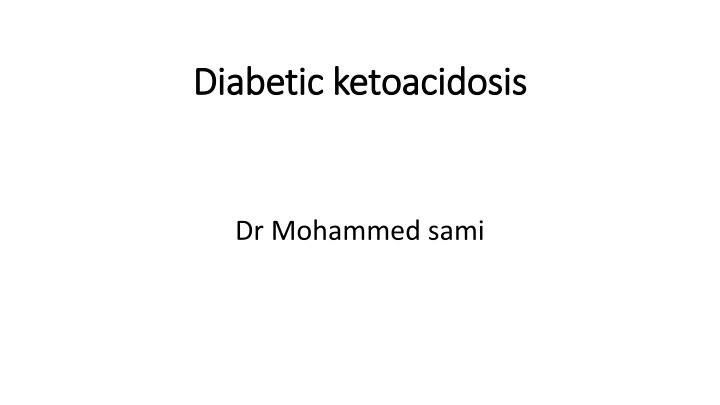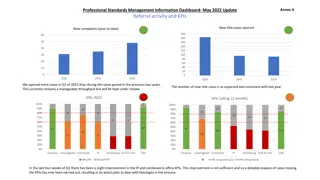
Understanding Diabetic Ketoacidosis (DKA)
Learn about Diabetic Ketoacidosis (DKA), a metabolic disorder characterized by hyperglycemia, acidosis, and ketonemia. Discover the signs, symptoms, diagnosis criteria, and management strategies for DKA to improve patient outcomes.
Download Presentation

Please find below an Image/Link to download the presentation.
The content on the website is provided AS IS for your information and personal use only. It may not be sold, licensed, or shared on other websites without obtaining consent from the author. If you encounter any issues during the download, it is possible that the publisher has removed the file from their server.
You are allowed to download the files provided on this website for personal or commercial use, subject to the condition that they are used lawfully. All files are the property of their respective owners.
The content on the website is provided AS IS for your information and personal use only. It may not be sold, licensed, or shared on other websites without obtaining consent from the author.
E N D
Presentation Transcript
Diabetic ketoacidosis Diabetic ketoacidosis Dr Mohammed sami
Definition Definition Diabetic ketoacidosis (DKA) is a metabolic disorder characterized by the presence of: . hyperglycaemia . acidosis . ketonaemia. It is more likely to occur in patients with type 1 diabetes, but is seen in patients with type 2 diabetes.
Signs and symptoms nausea and vomiting Thirst polyurea abdominal pain breathing becomes rapid and of a deep, gasping character, called "Kussmaul breathing abdomen may be In severe DKA, there may be confusion or a marked decrease in alertness, including coma
blood ketone level > 6 mmol/L bicarbonate level < 5 mmol/L arterial pH < 7.0 decreased GCS score (< 12) reduced oxygen saturations hypotension secondary to hypovolaemia (excessive diuresis) tachycardia anion gap > 16 mmol/L.
Management Management Management is based on: stabilization restoration of adequate circulation glucose control electrolyte replacement.
Stabilization The patient s ability to maintain an airway should be assessed. If the patient s GCS score is low, intubation and mechanical ventilation are likely to be needed. Frequent ABG measurements should be recorded to monitor O2, CO2, and pH levels.
Restoration of adequate circulation Water deficits high (estimated at 100 mL deficit/kg). Crystalloid fluid replacement is recommended. suggest 0.9 % saline with added premixed KCl. Rapid Target blood pressure is normally a systolic pressure of > 90 mmHg. CVS monitoring and invasive fluid assessment (e.g. CVP) may be required. Fluid balance should be closely monitored. The patient will require urinary catheterization.
Glucose control A fixed-rate IV insulin infusion (FRIII) , this should be related to weight, Give an insulin infusion of 50 units of soluble insulin in 50 mL of 0.9% saline. Current guidelines suggest that a fixed rate of 0.1 unit of insulin/ kg/h Regular blood glucose monitoring is essential. The blood glucose concentration should decrease by 3 mmol/h.
If the glucose concentration falls below 14 mmol/L in the first 6 h, IV glucose may be required. Blood ketones should be assessed regularly.
Electrolyte replacement Administration of IV insulin will reduce serum potassium levels. The recommended target range for potassium levels is 4 5 mmol/L. Monitor for signs of cardiac arrhythmias
Complications associated with DKA Complications associated with DKA . Hypokalaemia and hyperkalaemia Hypoglycaemia Cerebral oedema. Pulmonary oedema
Diabetes insipidus Diabetes insipidus Diabetes insipidus (DI) is caused by insufficient secretion of antidiuretic hormone (ADH). the kidneys secrete too much water, leading to significant fluid loss and hypovolaemia. High sodium levels are caused by the removal of excessive water, and serum osmolality will rapidly increase. Causes Nephrogenic DI causes genetic disorders renal diseases: pyelonephritis Neurogenic or central DI may be triggered by: cerebral oedema following traumatic brain injury damage to the pituitary gland (e.g. due to trauma, surgery, or stroke) tumours of the posterior pituitary gland, or removal of tumours of the pituitary gland.
Assessment Assessment polyuria polydipsia (if the patient is conscious) signs of dehydration hypotension tachycardia increased capillary refill time decreased CVP. Laboratory results may show: reduced levels of ADH high sodium levels high serum osmolality low urine osmolality low urinary specific gravity.
Management Management prevention of dehydration correction of sodium imbalance prevention of further complications. Nursing and medical management Careful recording of fluid intake and output is essential. Significant fluid replacement may be required if diuresis is excessive. Fluid replacement will be guided by blood results and the patient s condition. Neurogenic DI (central DI) responds well to administration of vasopressin, and this should be given as required to reduce urine output.
Status epilepticus Status epilepticus Five minutes or more of convulsions OR two or more convulsions in a five- minute period without return to preconvulsion neurological baseline. Significant brain injury can happen within half an hour. Early drug treatment is most effective at terminating seizure activity. Non-convulsive status epilepticus (seizure activity seen on EEG only) is also relevant to the ICU population. It is typically seen in patients with severely impaired mental status, for example following a traumatic brain injury and can be difficult to diagnose due to the lack of clinical signs. It carries a high mortality rate (61%).
CAUSES CAUSES ACUTE Metabolic disturbance electrolyte abnormalities, hypoglycaemia, renal failure Infection e.g. meningitis Vascular cerebrovascular accident (ischaemic or haemorrhagic Head injury Toxins Hypoxia
CHRONIC Tumours Epilepsy including noncompliance with medication Psychologically mediated
MANAGEMENT MANAGEMENT AIRWAY AND BREATHING secretions or bleeding from oral trauma, e.g. tongue biting. The airway may well be difficult to manage during generalised seizure activity so consider basic measures such as applying facemask oxygen and oral suctioning of secretions as able. Position the patient on their side inserting a nasopharyngeal Patients may need intubation and ventilation to protect the airway and control oxygenation. CIRCULATION hypertension and tachycardia are often seen
DRUG TREATMENT DRUG TREATMENT Lorazepam (0.1 mg/kg) up to 4 mg IV over about 2 minutes can be repeated after 10 minutes. Alternatively, diazepam 5 mg IV/10 20 mg PR Or midazolam 10 mg buccal Phenytoin loading dose 15 18 mg/kg at a rate of 50 mg/min. . General anaesthetic with thiopentone or propofol bolus and continued as an infusion. Consider midazolam infusion. Sedation continued for 12 24 hours after end of seizure activity then slowly weaned down. Avoid use of long acting neuromuscular blockers in order to observe for evidence of further seizures.
INVESTIGATIONS INVESTIGATIONS Electrocardiography (ECG) Chest X-ray (CXR) for infection, neurogenic pulmonary oedema and signs of aspiration Toxicology screen (urine) Electroencephalography (EEG) monitoring CT/MRI brain then relevant discussion with neurology or neurosurgical teams if required Lumbar puncture Blood cultures
















